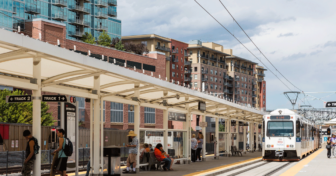![]() Just as talent––the asset that matters most to future economic growth––comes in all human varieties, talented people are looking for a wide variety of quality of place features in where they want to live and work. Probably most importantly, some are attracted to low-density car-oriented neighborhoods and communities and others––particularly a growing portion of young professionals––are attracted to high-density, walkable, transit-rich neighborhoods and communities.
Just as talent––the asset that matters most to future economic growth––comes in all human varieties, talented people are looking for a wide variety of quality of place features in where they want to live and work. Probably most importantly, some are attracted to low-density car-oriented neighborhoods and communities and others––particularly a growing portion of young professionals––are attracted to high-density, walkable, transit-rich neighborhoods and communities.
Our new report on creating places where people want to live and work argues that successful regions will be those that provide both kinds of neighborhoods and communities. The regions––no matter their size––that will be the most successful in retaining and attracting talent almost certainly will be those who offer a combination of high-quality high-density and high-quality low-density neighborhoods. The demand for high-density, walkable, transit-rich neighborhoods is not exclusive to central cities. The most successful regions are increasingly also characterized by inner ring suburban communities that provide walkable, dense neighborhoods.
Because having attractive, functioning cities must be a goal for the state, Michigan must align its economic development tools to foster urban redevelopment. Michigan cities have been so disinvested for so long, that they seriously lack in the amenities that knowledge workers want. Additionally, private developers still face challenges, costs, and risks in developing property in Michigan’s cities. While at some point the private market may stabilize such that the payoff will be worth these elevated costs, evidence suggests that it hasn’t yet.
We know how to create high-density, high-amenity, transit-rich neighborhoods, in both downtowns and inner-ring suburbs. National organizations like Smart Growth America, the Project for Public Spaces and the Urban Land Institute are a fount of knowledge about what to do and how to do it. In Michigan, for more than a decade, the Michigan State Housing Development Authority (MSHDA)-convened Sense of Place Council has brought together the relevant state agencies as well as local and state entities with placemaking expertise. They too have laid out what needs to be done and how to do it.
Fostering density
Some of the policy levers that other states have used effectively to create places where people want to live and work include:
Geographic targeting of incentives
Geographic targeting means strategically deploying state dollars for regions where growth is critical to the rest of the state. In Illinois, for example, the Business Location Efficiency Act increases, by ten percent, corporate income tax credits already offered under the Economic Development for a Growing Economy program for projects located near affordable housing and transit.[i]
Subsidize developments that contribute to density, particularly brownfield redevelopment
Michigan needs to increase its investment in downtowns, which means paying attention to the special costs of those project. The Maryland Heritage Structure Rehabilitation Tax Credit Program, which offers developers tax incentives of up to 20 percent of eligible rehab costs, led to the redevelopment of 407 commercial structures—with over $1.02 billion in spending by developers between 1996 and 2008.[ii]
Zoning
Standard zoning codes have the effect of prohibiting the mixed-use, pedestrian facing development that creates walkable urban places. One possible improvement lies in the implementation of form-based codes, which can promote walkable urban development, and have been adopted in many places (including Grand Rapids) as overlays to the existing zoning codes.[iii]
Promote housing in downtowns
Successful walkable places by definition include housing, of which there is not a sufficient supply in Michigan’s downtowns. The State of Michigan could help promote downtown housing by commissioning market studies and communicating the expected demand, making it easier for developers to feel confident in their investments.
Tax Incentive Evaluation
Michigan should also be making decisions on what tax incentives to grant based more on whether they retain and attract talent, rather than whether they retain and attract jobs. Since it is talent, not just numbers of jobs, that drive economic well-being. According to the Pew Charitable Trusts, 23 states have passed laws that require transparent measurement of their tax incentives between 2012 and 2016. We should consider a similar measure.
Encouraging regional decision making
As we wrote earlier, the desirable mix of infrastructure, basic services and amenities will differ from region to region. So Michigan’s diverse regions need the resources and flexibility to develop and implement their own strategies to retain and attract talent. It’s an essential ingredient to their future economic success.
In the Great Lakes, the best example of the power of regionalism is metro Minneapolis, the most prosperous region in the Great Lakes, by far. It has arguably the most powerful regional governance in the country. Regional collaboration, an elusive goal in many metropolitan areas, is on steroids in the Twin Cities. As we detail in our metro Minneapolis case study:
The seven-county Minneapolis metro area has been providing key governmental services, including waste- water treatment and transit, regionally for decades through what experts say is a unique entity called the Metropolitan Council, which recognizes that issues span political boundaries.
Unlike most regional planning agencies around the country that are organized as councils of local governments, the Met Council, as it’s known locally, has 17 members who are all appointed by the governor under state law. It is “more powerful and influential than any similar body in the United States,” said Minn-Post, a nonprofit news organization in Minneapolis.
Over time, the Met Council took on responsibility for operating the regional sewer and transit systems, and administering federal low-income housing vouchers. It also has purchased tens of millions of dollars worth of parkland and open spaces for a regional park system, created in 1974, that now includes 53 parks and 340 miles of interconnected trails.
Another unique aspect of regional collaboration in the Twin Cities region is a tax-base-sharing program known as Fiscal Disparities that requires nearly 200 local entities to share a portion of property tax dollars generated by industrial and commercial growth in the metro area. Fiscal Disparities is credited with reducing competition among local governments for development, helping less wealthy communities provide quality government services and allowing for better land-use planning.
The Met Council and Fiscal Disparities are seen as national models of regional cooperation and key elements in making metro Minneapolis one of the most livable regions of the country.
What metro Minneapolis teaches us is that:
- Regional governance is the result of state policy. Both the Met Council and Fiscal Disparities were created by state legislation
- Some essential services are best provided and paid for at the regional level
- Tax based sharing is an effective lever to reduce within region competition––which does nothing to grow the economy––for business location and in insuring that all parts of a region are able to better provide needed infrastructure, basic services and amenities.
Click here to read the new report on how Michigan can help its communities become talent magnets.
Photo credit: Alisafarov/Shutterstock.com.







